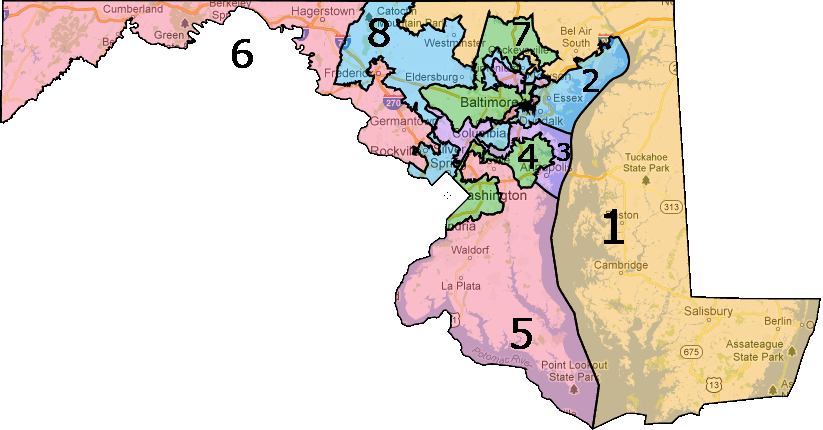
There’s a new political game in town. It’s called Larrymandering. Redistricting is legalized bodysnatching. Most politicians understand this. Both parties play the game. Gov. Larry Hogan’s playing it again, only in a different way.
So here we go again, trying to reduce a free and open democratic voting process into a mathematical formula of percentages and common denominators. Gov. Larry Hogan (R) is guilty of the very problem he claims he’s trying to correct. He’s deflecting the eye with a panel of Potemkin recruits.
Nobody ever claimed that politics is fair. Quotas and democracy are often self-canceling ideals. The Democrats tried it with their complex formula for selecting national convention delegates and they’re in a perpetual twist over how to keep it glued together.
Hogan is attempting to do the impossible. He’s trying to depoliticize politics. And Hogan’s promoting Larrymandering in the la la land notion that some of his Election Day mojo rubs off. Hogan jumped out well in advance of the March 7 deadline the court has laid down for the state to produce a new congressional map. State House Democratic leaders have so far been silent.
Hogan has created a commission, supposedly sanitized and nonpartisan, to redraw Maryland’s panhandle 6th Congressional District, just as he has also appointed a commission to promote the idea of taking the map-making task away from the politicians. And he’s doing it simply to try and pick up another Republican member of Congress. Now if that isn’t partisan political gerrymandering, what is?
Hogan no doubt knows that by rearranging the squiggles for the 6th, which Democrats admit they fashioned for partisan gain, the pieces for the entire westerly side of the map, and perhaps even beyond, must be readjusted as well. It’s like a balloon: Squeeze one place, and it pops out in another. The only districts that are sacrosanct, by court order, are those represented by minorities, i.e., Reps. Elijah Cummings (D-7th) and Anthony Brown (D-4th). Hogan should try getting around that when push comes to shove.
For the truth is, Maryland is a misshapen mess, cut in half by the Chesapeake Bay and scrunched to the west into a miserly sliver. The state, to be charitable, is not all picture-perfect and equally divisible squares and rectangles.

Frank A. DeFilippo
But Brian Frosh, the Democratic attorney general, has another, maybe brighter idea. He’s asked the Supreme Court to act in a way that would force all states to abide by the same rules on redistricting, so that no state(s) has an advantage, as Republicans have had through the past decade by gerrymandering.
This isn’t the first time Maryland’s been in a dogfight over redistricting. Following the 1960 census, Maryland was awarded an eighth member of Congress through population growth. The ministers of influence in Annapolis were unable to reconcile the difficulty of shuffling the map in a practical slice-and-dice way to make room for a new congressmember.
The major part of the mapmaking problem was that, at the time, Baltimore City had three self-contained congressmen of its very own, each in a senior position, and the rationale was to protect the seniority and its many benefits to the city and state. Maryland hadn’t yet considered breaching inviolate county boundary lines and contorting the map to establish population balance.
If the education of those three Baltimore members of Congress were added together, they wouldn’t have comprised a high school diploma. Rep. George Fallon was in the family sign-painting business; Rep. Edward Garmatz was an electrician at the old National Bohemian plant in East Baltimore; and Sam Friedel was in what was quaintly known at the time as being in the “small loan business.”
But they were among the most powerful members of Congress. As the dice rolled, Fallon was chairman of the House Public Works Committee, probably the most powerful committee in Congress for the award of pork barrel projects; Garmatz was chairman of the Merchant Marine and Fisheries Committee, which was vital to the Port of Baltimore; and Friedel was chairman of the House Operations Committee, which at the time controlled the congressional budget and gave Friedel the leverage to get pretty much anything he wanted.
It is worth noting, too, that the contentious 6th District, which was largely Republican but born again as majority Democratic through the admitted dark art of gerrymandering to include land-grab chunks of Montgomery County, has been bastardized. Be it known to the newly arrived that Montgomery County, in total, was the original 6th District and until recently elected mainly Republican members of Congress – Charles M. Mathias Jr. among them.
Nonetheless, the 1960s redistricting issue went to federal court in Baltimore where the hammer came down on the side of – and you’ve just heard this anew – either redistrict or the court will do it for you.
So the wise men and (at the time) a very few women conjured a novel idea: They created the office of congressman at-large. The new golem would have the statewide constituency of a U.S. senator but the portfolio of a district congressman.
In 1962, Carlton R. Sickles (D), a delegate from Prince George’s County and a labor lawyer, ran and won the at-large seat with the blanket support of organized labor and was reelected in 1964. Sickles used the office as a launch to run for governor in 1966 and was defeated in a four-way Democratic primary by George P. Mahoney by 1,900 votes.
The redistricting map, too, was finally redrawn for the 1966 election and the one-of-a-kind office of congressman at-large was consigned to an asterisk in the history books, never to be heard from again, anywhere.
The issue of congressional redistricting has been considered by the courts many times but never resolved.
The Supreme Court has two functions – to interpret the Constitution and to review existing laws. The difficulty for the courts is that the Constitution is vague on the issue. It states only that there shall be 435 congressional districts of roughly equal population – and that’s it – currently about 750,000. (Maryland’s population following the 2010 census was 5.773 million; its projected population following the 2020 census is set at roughly 6.4 million – thankfully, likely not enough for a ninth chair in Congress.)
Following each decennial census, states are awarded or lose representatives as their populations increase or decrease. And at the moment, the states with the greatest growth in population include California, Florida, Idaho, Texas, North Dakota, Utah, Nevada, South Carolina, Oregon and Arizona. It is impossible for other states to, say, replicate climate or unique employment opportunities.
By contrast, legislative reapportionment, redistricting’s equalizing companion, has its own set of guidelines – contiguity, commonality of interests, population balance. That’s because reapportionment is a late entry into mapmaking, the result of the 1960s “one man, one vote” ruling (which, incidentally, was brought before the Supreme Court by the wife of former Baltimore Police Commissioner Donald D. Pomerleau when she was a Ph.D. candidate in Georgia.)
Before the “one man, one vote ruling”, Maryland was governed under the old “unit rule” whereby each subdivision had one senator and three delegates, giving a small rural county equal voting power with large counties, and “local courtesy,” which allowed counties to exempt themselves from state laws. Baltimore City, at the time a population powerhouse, was carved into six districts, each with a senator and three delegates.
The reapportionment guidelines were written at the time of the ruling. (Following the 2000 census, the redistricting map drawn by former Democratic Gov. Parris Glendening was rejected and redrawn by the Maryland Court of Appeals. Glendening tried to redistrict several Baltimore County legislators out of office for defying him on votes on several bills.)
In the long view, the nation could be heading into dangerous territory. Questions are being raised about the disproportionate representation in the U.S. Senate – why, for example, should Wyoming, with a population of 600,000, have two senators, giving it the same say as California, with a population of 30 million? Here, the Constitution is very specific about each state having two senators, representing geography and not people.
Hogan, acting under the protective coloration of fairness, may have gained a short-term headline but it’s doubtful that he’ll enjoy a long-range advantage at the expense of majority Democrats. He can present his bipartisan Larrymandering plan and the General Assembly can reject it for a map of its own. And in the dance of legislation, the Assembly has more than enough votes to override any Hogan veto. So there’s a good chance a map of any flavor might end up in court again.
Hogan cites polls showing that 73 percent of the voters favor redistricting by a nonpartisan committee – there probably is no such thing – but the polls never asked voters whether they’d be willing to give up their member of Congress for a stranger. That’s what elections are for.
It appears, through experience and example, that there are two issues in politics that can’t be settled fairly by fiat or law, and they are money and redistricting.
The great post-Watergate campaign finance reform gave us political action committees and, ultimately, the curse we live with today, Citizens United, with its mysterious donors and dark money. And Republicans had a cuddly arrangement with redistricting for a decade wherein they controlled a majority of statehouses and, through those, until recently, all three branches of the federal government.
There is a self-correcting mechanism inherent in redistricting without all the ju-jitsu exhibitions in executive offices and the courts – win elections and enjoy the spoils. That’s the way God intended it.
Flip for Flip!
It’s great to read Frank DeFilippo’s columns.
It’s even better to have lunch with him!
Join us Wednesday, December 12, at noon, KO Public Affairs,
111 S. Calvert St. #2820, Baltimore, MD 21202
If you RSVP now, we can still get you a seat at the table! You may donate now or at the event. Suggested donation: $250 or $500.
Seating is limited. Kindly RSVP to Meg Thale at [email protected]
Help Maryland Matters produce independent, nonprofit, nonpartisan news.




 Creative Commons Attribution
Creative Commons Attribution